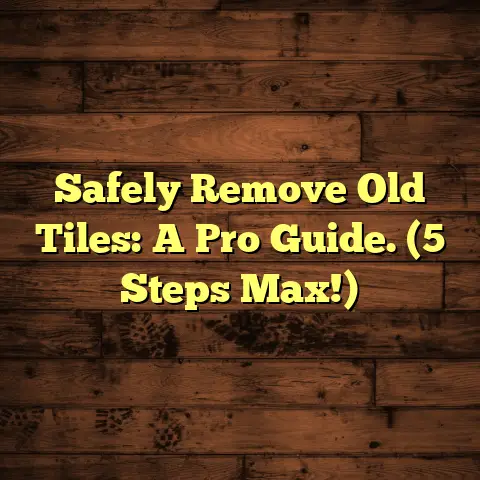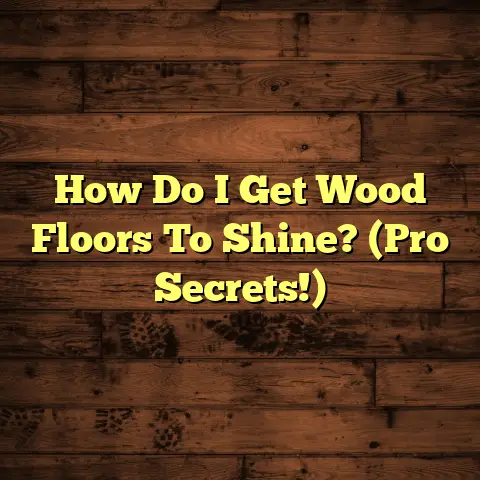Tar Paper Under Hardwood? (1 Mistake To Avoid!)
I’m a flooring contractor, and I’ve seen it all when it comes to flooring installations.
And let me tell you, choosing the right flooring is a big deal, especially when you’re aiming for durability that lasts for years.
Hardwood floors?
They’re gorgeous, timeless, and can seriously boost your home’s value.
But here’s the thing:
Even the best hardwood can fail if the installation isn’t done right.
That’s where I come in.
I’m here to share some insights, based on years of experience, on how to avoid common pitfalls and ensure your hardwood floors stand the test of time.
Today, we’re diving deep into a specific topic:
Tar paper under hardwood flooring.
Is it a good idea?
When should you use it?
And, most importantly, what’s the one mistake you absolutely must avoid?
Let’s get started!
Understanding Tar Paper and Its Purpose
Okay, so what exactly is tar paper?
Basically, it’s a heavy paper saturated with tar, creating a water-resistant material.
Think of it as a roofing underlayment, but also used in other construction applications.
It’s been around for ages, used to protect structures from moisture.
The Traditional Role of Tar Paper in Flooring
In flooring, tar paper has traditionally served a couple of key purposes:
-
Moisture Barrier: It acts as a barrier against moisture migrating from the subfloor to the hardwood. This is crucial because excessive moisture can cause hardwood to warp, cup, or even rot.
-
Underlayment: It provides a cushion between the subfloor and the hardwood, helping to reduce noise and provide a slightly softer feel underfoot.
Advantages of Using Tar Paper
Why did contractors use tar paper so often?
Well, it had a few things going for it:
-
Cost-Effective: Tar paper is relatively inexpensive compared to other underlayment options.
-
Easy to Install: It’s easy to roll out and staple or nail into place.
-
Readily Available: You can find it at pretty much any hardware store.
The Relationship Between Tar Paper and
Hardwood Flooring
Now, let’s talk about how tar paper interacts with hardwood.
It’s not always a straightforward relationship.
Potential Benefits and Drawbacks
While tar paper can offer some benefits, it also has potential drawbacks:
Benefits:
-
Moisture Protection: As mentioned earlier, it can help protect against moisture.
-
Sound Dampening: It can reduce some noise transmission.
Drawbacks:
-
Limited Breathability: Tar paper isn’t very breathable, which can trap moisture if it’s not properly installed.
-
Potential for Odor: Some tar paper can have a strong odor, especially when it’s new.
-
Not Ideal for All Hardwoods: It’s not always compatible with all types of hardwood, especially engineered hardwood.
Compatibility with Hardwood Types and
Installation Methods
The compatibility of tar paper depends on the type of hardwood and the installation method:
-
Solid Hardwood: Tar paper can be used with solid hardwood, but it’s crucial to ensure the subfloor is properly prepared and dry. Nail-down installations are more common with solid hardwood and tar paper.
-
Engineered Hardwood: Engineered hardwood is more dimensionally stable than solid hardwood, but it’s still susceptible to moisture damage.
Many manufacturers do not recommend using tar paper with engineered hardwood, especially in glue-down installations.
Why?
Because the tar paper can interfere with the adhesive bond.
Considering the Subfloor Type
The type of subfloor is also a crucial factor.
-
Wood Subfloors: Tar paper can be used over wood subfloors, but it’s essential to ensure the subfloor is level, dry, and free of any mold or mildew.
-
Concrete Subfloors: Concrete subfloors are more prone to moisture issues.
If you’re using tar paper over concrete, you must ensure that the concrete is properly sealed and that a moisture test is performed to ensure it meets the hardwood manufacturer’s specifications.
Using a more modern moisture barrier is often a better choice here.
The One Mistake to Avoid
Alright, let’s get to the heart of the matter.
What’s the one mistake you absolutely must avoid when using tar paper under hardwood?
The Mistake: Assuming Tar Paper is a Sufficient Moisture Barrier in All Situations.
That’s it.
It sounds simple, but it’s a mistake I see all the time.
Homeowners and even some contractors assume that because tar paper acts as a moisture barrier, it’s always enough.
But that’s just not true.
Implications of This Mistake
What happens when you rely solely on tar paper as a moisture barrier when it’s not sufficient?
Here’s what you can expect:
-
Cupping and Warping: Excessive moisture can cause the hardwood to cup (where the edges rise) or warp.
-
Buckling: In severe cases, the hardwood can buckle, lifting off the subfloor.
-
Mold and Mildew Growth: Trapped moisture can create a breeding ground for mold and mildew, which can be harmful to your health.
-
Adhesive Failure (Glue-Down): In glue-down installations, excessive moisture can weaken the adhesive bond, causing the hardwood to loosen.
-
Reduced Lifespan: Ultimately, excessive moisture will shorten the lifespan of your hardwood floors.
Real-World Examples
I’ve seen this play out countless times.
I remember one homeowner who installed solid hardwood over a concrete subfloor using only tar paper as a moisture barrier.
Within a year, the floors started to cup and warp.
It turned out the concrete subfloor had a high moisture content.
The tar paper simply couldn’t handle it.
The homeowner ended up having to replace the entire floor, costing them thousands of dollars.
Here is a table showing the cost of hardwood floor installation and the impact of moisture damage:
| Scenario | Installation Cost | Repair/Replacement Cost | Total Cost |
|---|---|---|---|
| New Install, No Issues | \$8,000 | \$0 | \$8,000 |
| Moisture Damage, Repair | \$8,000 | \$2,000 | \$10,000 |
| Moisture Damage, Replace | \$8,000 | \$8,000 | \$16,000 |
These numbers are estimates and can vary based on location, materials, and labor costs.
Another case involved engineered hardwood installed over a wood subfloor with tar paper.
The homeowner didn’t properly acclimate the hardwood before installation, and the tar paper trapped moisture.
The floors started to buckle in a few spots, and the homeowner had to pay for costly repairs.
Expert Opinions and Industry Standards
So, what do the experts say about using tar paper under hardwood?
Insights from Flooring Professionals
Most flooring experts agree that tar paper has largely been replaced by more modern and effective moisture barriers.
Many professionals recommend using a polyethylene film or a specialized underlayment with a built-in moisture barrier.
These products offer better moisture protection and breathability than tar paper.
For example, the National Wood Flooring Association (NWFA) recommends following the hardwood manufacturer’s guidelines for moisture control.
Here’s a quote from a fellow flooring contractor:
“I haven’t used tar paper in years. There are just better products available now that offer superior moisture protection and are easier to install.”
Industry Standards and Guidelines
The NWFA provides detailed guidelines for hardwood flooring installation, including recommendations for moisture control.
These guidelines emphasize the importance of testing the subfloor for moisture content and using appropriate moisture barriers based on the specific conditions.
The Maple Flooring Manufacturers Association (MFMA) also offers technical information on hardwood flooring, including best practices for moisture management.
Emerging Trends and Alternative Materials
The flooring industry is constantly evolving, and new products are always being developed.
Some emerging trends in moisture barriers include:
-
Self-Adhering Membranes: These membranes provide a waterproof barrier and are easy to install.
-
Liquid-Applied Moisture Barriers: These barriers are applied like paint and create a seamless, waterproof layer.
-
Underlayments with Integrated Moisture Barriers: These underlayments combine cushioning and moisture protection in a single product.
Conclusion: The Lasting Impact of Proper
Installation
Alright, we’ve covered a lot of ground.
Let’s recap the key takeaways:
-
Don’t assume tar paper is always a sufficient moisture barrier.
-
Test your subfloor for moisture content.
-
Follow the hardwood manufacturer’s recommendations for moisture control.
-
Consider using more modern moisture barrier products.
By avoiding the mistake of relying solely on tar paper as a moisture barrier, you can significantly enhance the durability and longevity of your hardwood floors.
Investing in proper installation and moisture control is well worth the cost.
It can save you thousands of dollars in repairs or replacements down the road.
Ultimately, the key to beautiful, long-lasting hardwood floors is to do your research, consult with professionals, and make informed choices every step of the way.
Don’t cut corners when it comes to moisture protection.
Your floors (and your wallet) will thank you for it!





